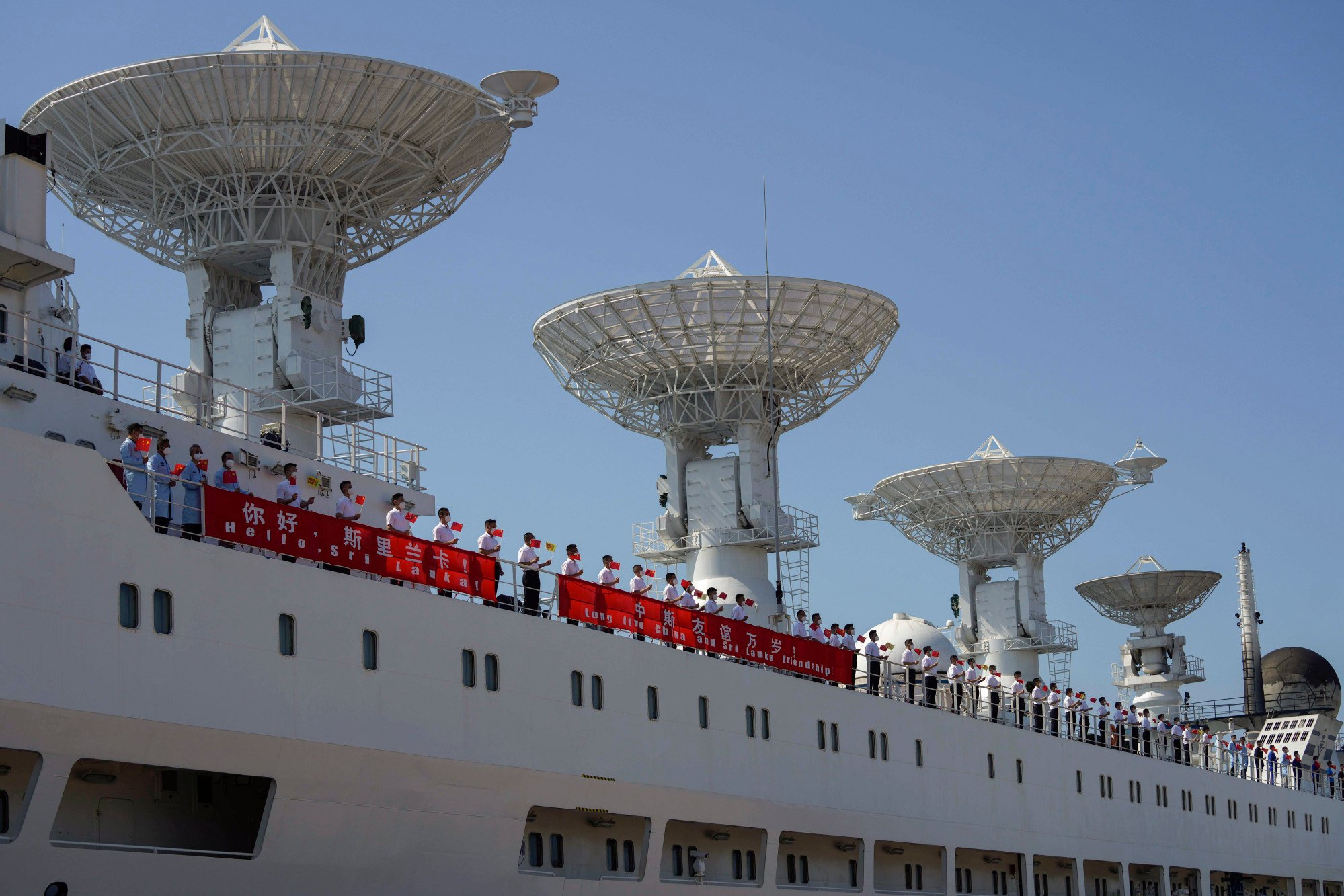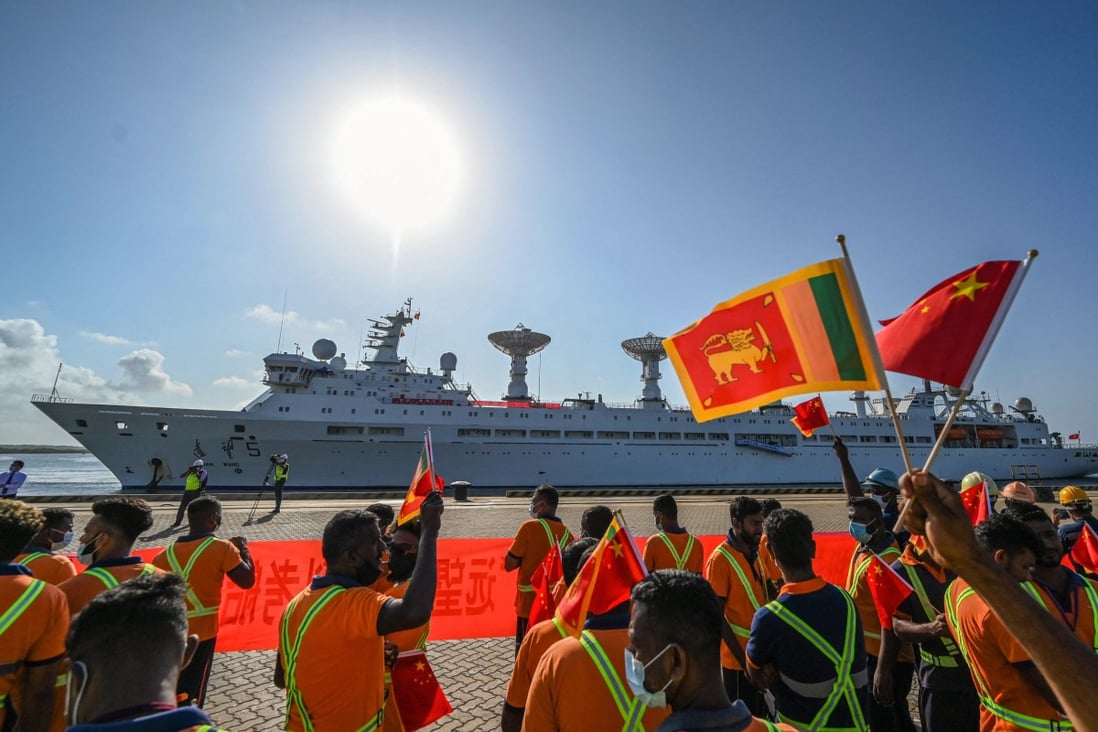by Ling Xin
- Sri Lanka has allowed it to dock at its Hambantota port despite objections from India
- The vessel tracks rocket and spacecraft launches, but foreign media have called it a ‘spy ship’
The Chinese ship Yuan Wang 5 has sailed international waters for 15 years, attracting little attention until this month, when it suddenly sparked a diplomatic scuffle.
The vessel tracks rocket and spacecraft launches for China’s manned space programme and moon exploration missions. But some have called it a “spy ship”, which has led to the current controversy.
On Tuesday morning, the Sri Lankan government allowed Yuan Wang 5 to dock at its Hambantota port despite India’s objections. An unnamed port official told Reuters it would stock up on fuel, food and other essentials.
So what does Yuan Wang 5 do, and how concerned should China’s neighbours be?
What is Yuan Wang 5?
Yuan Wang 5 is a large tracking ship China uses to monitor and control rockets, satellites and test missiles while they are over the ocean and beyond the range of ground stations.
The ship is 222 metres (728 feet) long and 25 metres wide and is equipped with massive satellite dishes and radar systems. It can continuously monitor the status of a rocket launch and instruct a spacecraft to change its orbit or unfurl its solar panels in space.
Built in 2007, Yuan Wang 5 has been regularly deployed by its operator – China Satellite Maritime Tracking and Control Department – to the Central Pacific and the Indian Ocean to support satellite launches. Its base port is in Jiangyin, near Shanghai on the Yangtze River.

What missions has Yuan Wang 5 carried out?
Yuan Wang 5 has been heavily involved in China’s manned space programme, moon and Mars exploration as well as the construction of the Beidou navigation satellite system.
According to the state-run Xinhua News Agency, the ship has completed more than 80 maritime tracking missions in the past 15 years. It has sailed more than 570,000 nautical miles and berthed at a number of international ports.
For example, after performing tracking duties for the rendezvous of the Shenzhou-10 manned spacecraft and Tiangong-1 space lab in July 2013, the vessel docked at Indonesia’s Tanjung Priok port for seven days of replenishment and equipment maintenance.
What is the ship doing near Sri Lanka?
Last month, Yuan Wang 5 carried out a major tracking mission to support the launch of Wentian, a major component of China’s space station, which is now under construction in low earth orbit.
Earlier this month, the ship headed towards the northwestern Indian Ocean, where it will conduct satellite control and research tracking through September, according to India’s Times Now news channel.
Originally expected to arrive at Hambantota International Port in southern Sri Lanka on August 11 for replenishment, Yuan Wang 5 was told by the Sri Lankan government to postpone its visit because of concerns from outside the country.
Yuan Wang 5 has a crew of over 400, including technicians and experts, according to Indian media. The ship’s captain is Zhang Hongwang, China’s Science & Technology Daily reported.
Who is concerned – and why?
India and the United States have expressed security concerns over Yuan Wang 5’s arrival.
After learning that the ship was involved in space and satellite tracking, India’s Ministry of External Affairs said in late July that it would “closely monitor any bearing on India’s security and economic interests and take all measures to safeguard them”.
Yuan Wang 5 has been referred to as a “spy ship” by Indian media, including the widely circulated Indian Express, Hindustan Times and India Today.
After struggling to pay its debts to China, Sri Lanka leased the Hambantota port to a Chinese company, which has run it since 2017. The port is considered strategically important because of its location near the main Asia-Europe shipping route.
In its 2021 annual report to Congress, the US Defence Department said that China was “pursuing additional military facilities to support naval, air, ground, cyber, and space power projection,” and had “likely considered a number of countries as locations” for People’s Liberation Army facilities, including Sri Lanka.
The US leads the world in its number of military bases, with about 750 facilities in 80 nations, according to the Cato Institute. China has one military base in Djibouti in east Africa.
How does Yuan Wang 5 compare to other tracking ships?
China is the fourth country to have its own tracking ships, following the US, France, and the Soviet Union.
Compared with a typical US tracking ship, the Yuan Wang vessels are much larger because they must carry many different types of instruments.
“The US can build smaller, cheaper tracking ships with fewer instruments because they have military bases and ground stations all over the world. China can’t,” said Xu Xueyan, the ships’ chief designer, in a 2005 interview with Modern Ship magazine.
India’s first tracking ship entered service in 2020, and a second one reportedly underwent sea trials in late 2021.
Will China build more tracking ships?
We don’t know. China has built seven Yuan Wang tracking ships since the 1970s, four of which are active. They allow China to conduct tracking missions in international waters, but “operating them is expensive,” and the number of ships is limited compared to demand, according to a report compiled by the China Aerospace Studies Institute, a US Air Force think tank based in Alabama.
Meanwhile, China has launched a total of eight Tian Lian satellites for data tracking and communications relay from space. Any three Tian Lian satellites can form a network with nearly 100 per cent coverage for tracking a spacecraft, according to a People’s Liberation Army Daily report from June 6.
Because of the satellite network and technological advances, recent launches have required fewer tracking ships. Only one Yuan Wang ship was needed for the Shenzhou 14 launch in June, compared to five ships sent to support the Shenzhou 7 mission in 2008.
A tracking network of ground stations, tracking ships and satellites can cut costs and is likely to become the main system for supporting China’s manned space programme in the future, the report said.
Ling Xin is a science journalist based in Beijing. She mainly covers physics, astronomy and space. Her writing has appeared in Science, Scientific American, MIT Technology Review and other English and Chinese outlets. She was a visiting journalist at Science magazine in Washington, and has a master’s degree in journalism from Ohio University.
Source: South China Morning Post

